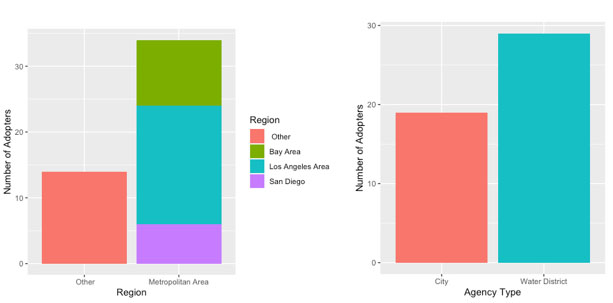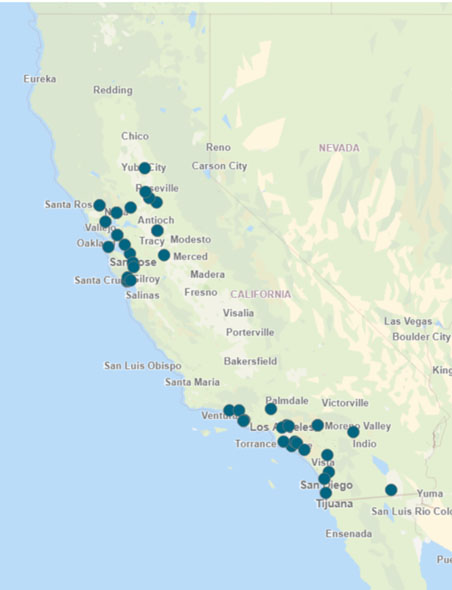AMI Adoption: Challenges And Opportunities For Local Water Providers In California
By Ishana Ratan, PhD Candidate, UC Berkeley; Alison Post, Associate Professor, UC Berkeley; and David Cox, PE, President, FirmoGraphs LLC

Advanced metering infrastructure (AMI) integrates hardware, data management, and communications systems for real-time data collection with two-way communication between water service providers and their customers. This technology is particularly impactful in drought prone areas, incentivizing water conservation and alerting both service providers and consumers to possible leaks in real time (Moore and Hughes 2008). Researchers at UC Berkeley have used FirmoGraphs’ database of meeting minutes and capital improvement plans to analyze recent trends in AMI adoption among California drinking water agencies. In the last two years, nearly 50 cities and water districts have adopted advanced metering infrastructure. More recent AMI adopters are located in the Bay Area, Los Angeles, and San Diego metro areas than the remaining regions of California, which include agricultural areas.

Figure 1: AMI adoption by region and agency type, California (from FirmoGraphs data)
What factors contribute to or inhibit adoption for these local leaders? In meeting minutes and capital improvement plans, agencies emphasize AMI benefits to consumers: real-time leak notifications both lower bills and limit water losses. At board meetings in the city of Santa Cruz, participants noted that two-way communication allows agencies to troubleshoot leaks with customers in real time, instead of the one-way information sharing model of advanced meter reading (AMR). AMI also promotes customer engagement beyond immediate leaks. For example, meeting minutes reveal that North Marin Water District experienced an increase in customer website usage after launching their online interface for water consumption tracking. Similarly, capital improvement plans from San Diego, Fullerton, and Thousand Oaks emphasize consumer awareness of water consumption as a key benefit of this technology.
The following map shows the location of the water systems within this review.

However, both the cost of AMI technology and technological complexity of rollout remain a challenge. In order to distribute costs while minimizing increases to ratepayers, agencies like El Toro Water District and East Bay Municipal Utility District have sequenced deployment in stages. Agencies often start with a pilot program, then meter infrastructure installation at scale, and finally develop customer portals. Sequenced deployment also eases the burden of the transition away from traditional systems on consumers. For example, the city of San Jose provided alternative leak detection alerts to consumers with old meters via text and email during AMI rollout. Others like San Bernardino Municipal Water District and Las Virgenes Municipal Water District have used state and federal incentives like the WaterSMART Water and Energy Efficiency Grant program to support AMI deployment. Inter-agency collaboration can also facilitate funding; Rincon del Diablo Municipal Water District partnered with San Diego Integrated Regional Water Management Program to secure grant funding for AMI deployment.
Overall, agencies in California have adopted AMI to support water conservation and consumer engagement, particularly in urban areas with technologically savvy users. While AMI deployment can be costly, strategic rollout and state grant support have impactfully helped agencies manage adoption. Knowledge sharing between early adopters and prospective agencies can also facilitate technology adoption going forward.
